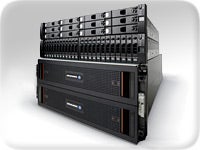

AMD revealed its “ambidextrous strategy” today, an effort by the computer processor company to make a splash in the big data center market and turn its flagging fortunes around.
The company announced a partnership with ARM that will bring AMD’s low-power mobile processor technology to the data center. During a press conference, AMD CEO Rory Read (via live remote) and Lisa Su, senior vice president and general manager of Global Business Units, announced that the companies are building 64-bit ARM-based server CPUs.
AMD is planning a highly-integrated, ARM-based 64-bit multicore System-on-a-Chip (SoC) for dense, low-power servers aimed at large cloud computing facilities. The first ARM-based Opteron systems are expected to launch in 2014, according to AMD.
Su describes the move as an “opportunity to accelerate the adoption of ARM in the data center.”
 In a blog post, she details how the chips that power smartphones and tablets have the potential to transform the economics of running today’s massive cloud data centers.
In a blog post, she details how the chips that power smartphones and tablets have the potential to transform the economics of running today’s massive cloud data centers.
Su states, “Small and efficient CPUs, like ARM CPUs, bring a very unique capability to the data center. The compute/$ and compute/watt is substantially improved in ARM CPUs over large-core CPUs, thus making them ideal for highly parallelizable tasks.”
She adds that despite this efficiency-boosting potential, linking these CPUs to the network is not without its challenges. Enter SeaMicro.
“AMD, through our SeaMicro acquisition, has the industry’s premier fabric, the AMD SeaMicro Freedom fabric. By using Freedom fabric to link ARM-based CPUs into a cluster, and then linking the clusters to the network, AMD can effectively solve the bottleneck of leveraging small, efficient CPUs in the mega data centers of tomorrow,” claims Su.
In March, AMD snapped up SeaMicro, a startup that specialized in packaging dozens of low-power CPUs into dense servers capable of handling data center workloads at a fraction of the power consumption compared to traditional server architectures. Last month, the company announced the SeaMicro SM15000server, which can accommodate up to 64 AMD “Piledriver” Opterons or 64 Intel “Ivy Bridge” Xeon processors.
While the ARM and SeaMicro angle may compel big cloud players, AMD is still committed to x86 — hence the company’s “ambidextrous” approach to large-scale computing.
“The best part of it is that we provide customers choice. In addition to ARM-based CPUs, AMD will continue to offer x86 CPUs and APUs so that customers can use the right processor for the right workload,” concludes Su.
Pedro Hernandez is a contributing editor at InternetNews.com, the news service of the IT Business Edge Network, the network for technology professionals. Follow him on Twitter @ecoINSITE.
Property of TechnologyAdvice. © 2025 TechnologyAdvice. All Rights Reserved
Advertiser Disclosure: Some of the products that appear on this site are from companies from which TechnologyAdvice receives compensation. This compensation may impact how and where products appear on this site including, for example, the order in which they appear. TechnologyAdvice does not include all companies or all types of products available in the marketplace.